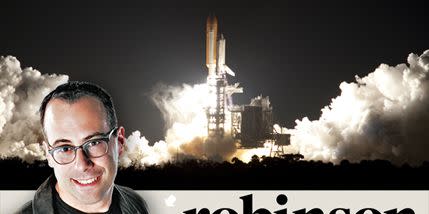Aaron Robinson: From Orbit, You Can't see America Sliding Backward into Mediocrity



Mrs. Robinson and I are out 700 bucks for airfare to Orlando, several hundred dollars in hotel and Denny’s dining bills, and $88 for little blue tickets that allow us to sit on damp grass at 4:42 in the morning with thousands of shivering strangers, all of us staring dejectedly at a blank, black sky.
Three minutes ago, pyrotechnic fuses atop two 149-foot-long cylinders full of 2.2 million pounds of ammonium perchlorate and aluminum were supposed to ignite, creating an incandescent spume of gases that, combined with the 6000-degree exhaust of three rockets guzzling liquid hydrogen and oxygen at the rate of 1038 gallons per second, should have rifled the 4.5-million-pound space shuttle off pad 39A at the Kennedy Space Center.
Launch veterans tell me it’ll look like a sunrise come two hours early. But low clouds have wafted in during the final countdown and scrubbed the launch until tomorrow—maybe, if the weather cooperates.
After this one, four more extra sunrises are scheduled before the government scraps the shuttle program. Manned spaceflight in America will go on indefinite hiatus as NASA pays Russia and private companies to staff and resupply the orbiting International Space Station. Two of the three surviving orbiters are to be sold. What with the recession and everything, NASA recently knocked $13 million off the $42 million asking price of an orbiter. Do not send cash.
We’ve been back and forth across the Cape for two days, and everywhere the crowds are thick. Cars and campers line the narrow lanes and bucolic back bays around Florida’s Intracoastal Waterway. After a launch scrub, I’ve learned, the traffic is that of two or three Super Bowls.

For an agency that keeps its clocks wound on just $18 billion annually, or about one-half of one percent of the 2009 federal budget, NASA stokes a disproportionate share of the public imagination. Social Security, Medicare, and Medicaid vacuumed up almost $1.4 trillion last year, but so far there’s no teeming visitor center or T-shirt concession. Who wants to sit on wet grass all night watching checks being printed?
It’s not just that it’s more fun to see rocket fuel burn than it is to see ailing folks get help. While rockets are pretty cool, rockets with people at the pointy end are a whole different level of experiential drama. The shuttle is part of the legacy of manned-spaceflight machinery washed up on the beach at America’s technological high-water mark. Its blazing arc across a night sky is an affirmation that a dynamic democracy thinks big and produces audacious engineering.
Or, it did once upon a time.
NASA’s slow stall parallels Detroit’s. The new Constellation moon program was just canned in President Obama’s 2011 budget proposal, and 7000 jobs will evaporate at the space center when the shuttles are parked. Expertise will boil off like liquid hydrogen on a hot plate, and America’s manned space glory will begin to fade in its rear view.
Politicians often tell us that the U.S. is No. 1, but occasionally the rank and file needs proof with something besides the per-capita consumption of chicken nuggets. Call us simplistic; say we’re drunk on the tonic of superficial symbology, but We the People need occasional collective amazement as much as we need an affordable doctor. We need feats and triumphs and technological wow moments, so we can point and say, “We did that.” It’s even better if those triumphs light up a night sky.
Or an auto-show stand.
You may not get warm reading technical briefs on a hydrogen-powered vehicle that seats seven and goes 17,500 mph, but there’s a good chance the people engineering your next car do. A country that desires its engineers and technicians to keep the pace must demonstrate that it values their work, that it offers a future to them besides continuous frustration and third-place finishes.
Mike Ger, an old friend sharing the damp grass with us, is master’s degreed in mechanical engineering and bonkers for cars. While we wait, he tells us how he was begged, literally begged, by his faculty advisor at the university to stay on and get a doctorate because the advisor hadn’t had an American Ph.D. engineering candidate in seven years. Ger eventually left hidebound GM for the greater opportunities offered by the still-innovating software industry.
What, we wonder in the idle hours of a near-freezing night in February, will our politicians tell us if China stages the next moon landing? Or builds the first usable electric car at an affordable price?
At 4:14 the next morning, Endeavour rode its own sunrise into space, Old Glory branded on the starboard wing. Four-and-a-half minutes later, it was 65 miles high, a flickering pinpoint dropping to the horizon.
At the height of the Apollo moon program, it consumed half the world’s output of integrated circuits. Anybody use a cell phone lately? If we lose our appetite for technical audacity and dismiss the people who supply it, it seems logical to expect all of our native industries, including our automakers, to fall further behind. How do you get a kid to look up from a Malaysian-made game console and consider becoming an engineer? Give her something stunning to see.
You Might Also Like

 Yahoo Autos
Yahoo Autos 